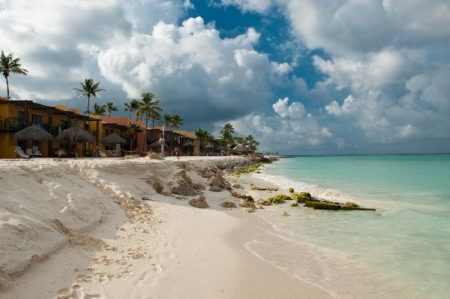December 9, 2019 – Before I receive reader comments about taking a commercial jet to fly to Aruba, I apologize for the carbon contribution and will be buying carbon offsets upon our return. The tickets show the amount of carbon contribution so I can accurately come up with the amount I need to contribute to a legitimate carbon offset provider. In this case, I will use Terrapass.
Aruba is a desert island to the north of Venezuela in the Caribbean Sea. It has no natural water sources and very little rain, although yesterday two passing showers betrayed that fact. There is a constant wind that blows here without respite. It is the Trade Winds that brought European explorers to the Americas in the 15th and 16th centuries. The sun shines on this island almost every day, probably more than almost any other place on the planet.
Knowing these latter two facts would make you think, what an ideal place to use renewable solar and wind. But surprisingly, there is little evidence of either here. The island, being close to Venezuela imports that country’s heavy oil which is refined and used for power generation and transportation. Ther are early signs of a growing utility-based renewable energy infrastructure, and many homes have solar water heaters and photovoltaic panels. But this island, if any, should be totally powered by renewable sources.
There is one significant challenge and that is the lack of fresh water. Aruba gets all of its fresh water from the Caribbean through a desalination plant that serves the island’s permanent inhabitants and the burgeoning tourism trade.
The choice of coming here was to give both of us a chance to be outside as winter descends on Toronto, bringing grey skies, short days with little sunlight, the cold, and ice and snow. For my wife who suffered a concussion a year ago when she fell, being able to walk without fear of falling is a blessing. For me, with a pending knee replacement in the offing, the ability to not have to deal with the ice and snow means I can get around although I am using brace and cane to achieve this. My surgery is scheduled in the spring after the winter snow has passed.
So if you are a regular reader of this blog, I will be firing on all cylinders in a week’s time. In the meantime, go to the home page of the site to follow the Twitter feed which I regularly update even while traveling. It can be found on the right-hand side of the site. And if I come across a new video to share you will find it as well farther down on the right side.
I want to thank the more than 50,000 subscribers who regularly receive this content, and the millions of page views that readers have given to this site. After more than nine years at this task, and nearly 2,900 postings, your continued interest inspires me to tackle the progress of science, technology, and environmental policy and actions in this 21st century.









